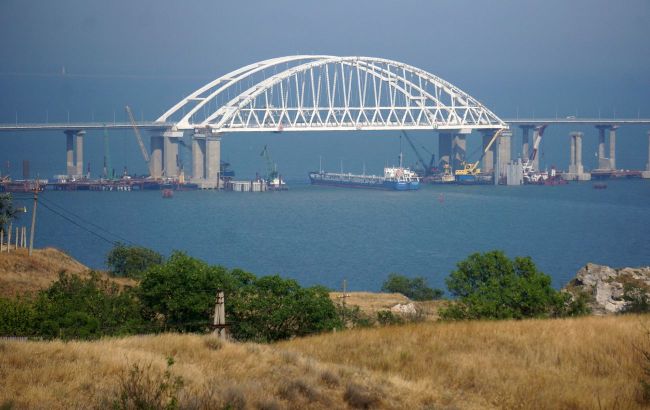Crimean Bridge has no chance: Ukraine's defense intelligence prepares third strike
 The Kerch Bridge will be destroyed in the first half of 2024 (Getty Images)
The Kerch Bridge will be destroyed in the first half of 2024 (Getty Images)
Ukrainian Defense Intelligence Directorate is preparing for a third strike on the Kerch Bridge which links Russian territory to the occupied Crimea, according to The Guardian.
High-ranking representatives of the Directorate reported that the destruction of the bridge is "inevitable".
The Directorate believes that it will soon be able to disable the bridge.
"We will do it in the first half of 2024," said one of the officials to The Guardian, adding that the head of intelligence Kyrylo Budanov already has "most of the means to carry out this goal". He is following the plan approved by Ukrainian President Volodymyr Zelenskyy to "minimize" Russia's naval presence in the Black Sea.
As noted by The Guardian, for Vladimir Putin, the bridge is a tangible reminder of what he considers one of his greatest political achievements: the "return" of the peninsula to Russia in 2014 using secret Russian troops and a staged referendum.
For Kyiv, the bridge is an equally detestable symbol of the Kremlin's illegal annexation. Its destruction will strengthen Ukraine's campaign to liberate Crimea and boost morale on the battlefield and beyond, where Kyiv's forces are gradually retreating.
According to The Guardian, it is currently unclear how the strike will be carried out, but there are serious doubts about whether the Directorate is capable of conducting a special operation against such a well-defended and obvious target. Russia has taken extensive measures to protect the bridge, strengthening anti-aircraft defences and deploying a "target barge" as a decoy for incoming guided missiles.
In the last five months, Ukraine has sunk seven ships of the Moscow Black Sea Fleet. The latest of these, the Sergei Kotov, was liquidated earlier this month after a night raid involving 10 Ukrainian amphibious drones, the Magura V5, laden with explosives while patrolling south of the Kerch Bridge. Directorate representatives stated that this was a "shaping operation" ahead of a new attack on the bridge.
Previously, the bridge had been struck twice and repaired. A Ukrainian drone strike in July last year caused significant damage to the road section parallel to the railway section used by Russian military to transport tanks and cargo. In October 2022, an explosion of a bomb clandestinely carried in a truck caused several sections of the road to collapse into the water.
Taurus missiles needed
If the bridge were to be permanently disabled, Moscow would have to transport military cargo by roads through the occupied south of Ukraine. The route would pass through the Kherson and Zaporizhzhia regions, which Russia partially seized in spring 2022. Ukrainian officials believe this would significantly limit the Kremlin's ability to conduct offensive operations at a time when its ground forces are advancing.
Officials indicated that Western weaponry would enable Ukraine to destroy the bridge faster, and Zelenskyy has repeatedly asked Berlin to provide him with long-range missile systems to escalate tensions.
Earlier this month, pro-Kremlin Russian channels released intercepted phone conversations in which senior German military officials discussed the possibility of using Taurus missiles. According to experts' estimates, 10-20 missiles would likely be sufficient to destroy the bridge.
Deputy to Budanov, Major General Vadym Skibitskyi, said Western politicians were mistaken in fearing an escalation of the conflict. "What does escalation mean for us? We have had two years of war. It’s an everyday procedure," he said. "Russia bombs our territory. It hits power stations and civilian infrastructure."
Russian rear targeted
Skibitskyi said that victory on the battlefield is currently impossible, considering Russia's military advantage and the lack of artillery shells and fighters on the Ukrainian side. He suggested that Kyiv has "no choice" but to start fighting in the enemy's deep rear, including military infrastructure, command and control centers, as well as industrial facilities producing "weapons and munitions."
He added that Kyiv has used NATO's standard procedure known as centre of gravity or Cog, a model where significant results can be achieved by selecting and then eliminating a few carefully chosen particularly important targets.
In recent months, the Directorate has aimed to destroy Russia's oil refining capacities. According to Skibitskyi, Ukraine planned to inflict more strikes on Russian objects, with undercover agents playing a role in this. Some were "Russians with Ukrainian roots", others were non-ideological Russians recruited for money. He said the pool was so large that the Directorate could choose candidates for sabotage operations.
Drone strikes on Russian refineries
In recent months, Ukraine has begun attacking refineries in Russia, the world's second-largest oil exporter, negatively impacting Moscow's lucrative trade in oil products.
According to Reuters estimates, about 14% of Russia's oil refining capacity has been halted by drone attacks.
In particular, on April 2, Ukraine launched a massive drone strike on Russian territory. The third-largest Russian refinery and the production of Shahed drones were damaged in Tatarstan.

